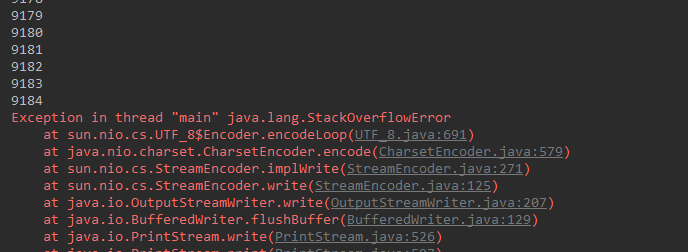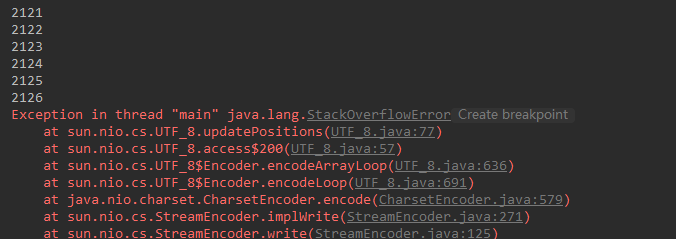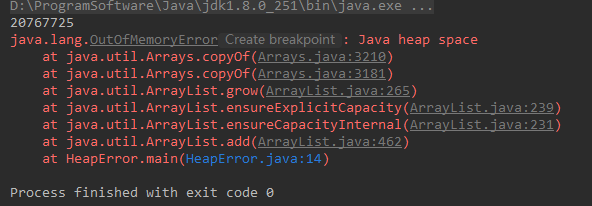詳解JVM棧溢出和堆溢出
一、棧溢出StackOverflowError
棧是線程私有的,生命周期與線程相同,每個方法在執行的時候都會創建一個棧幀,用來存儲局部變量表,操作數棧,動態鏈接,方法出口等信息。
棧溢出:方法執行時創建的棧幀個數超過瞭棧的深度。
原因舉例:方法遞歸
【示例】:
public class StackError {
private int i = 0;
public void fn() {
System.out.println(i++);
fn();
}
public static void main(String[] args) {
StackError stackError = new StackError();
stackError.fn();
}
}
【輸出】:

解決方法:調整JVM棧的大小:-Xss
-Xss size
Sets the thread stack size (in bytes). Append the letter
korKto indicate KB,morMto indicate MB, andgorGto indicate GB. The default value depends on the platform:Linux/x64 (64-bit): 1024 KBmacOS (64-bit): 1024 KBOracle Solaris/x64 (64-bit): 1024 KBWindows: The default value depends on virtual memory
The following examples set the thread stack size to 1024 KB in different units:
-Xss1m
-Xss1024k
-Xss1048576This option is similar to
-XX:ThreadStackSize.
在IDEA中點擊Run菜單的Edit Configuration如下圖:

設置後,再次運行,會發現i的值變小,這是因為設置的-Xss值比原來的小:

二、堆溢出OutOfMemoryError:Java heap space
堆中主要存放的是對象。
堆溢出:不斷的new對象會導致堆中空間溢出。如果虛擬機的棧內存允許動態擴展,當擴展棧容量無法申請到足夠的內存時。
【示例】:
public class HeapError {
public static void main(String[] args) {
List<String> list = new ArrayList<>();
try {
while (true) {
list.add("Floweryu");
}
} catch (Throwable e) {
System.out.println(list.size());
e.printStackTrace();
}
}
}
【輸出】:

解決方法:調整堆的大小:Xmx
-Xmx size
Specifies the maximum size (in bytes) of the memory allocation pool in bytes. This value must be a multiple of 1024 and greater than 2 MB. Append the letter
korKto indicate kilobytes,morMto indicate megabytes, andgorGto indicate gigabytes. The default value is chosen at runtime based on system configuration. For server deployments,-Xmsand-Xmxare often set to the same value. The following examples show how to set the maximum allowed size of allocated memory to 80 MB by using various units:-Xmx83886080
-Xmx81920k
-Xmx80mThe
-Xmxoption is equivalent to-XX:MaxHeapSize.
設置-Xmx256M後,輸入如下,比之前小:

到此這篇關於詳解JVM棧溢出和堆溢出的文章就介紹到這瞭,更多相關棧溢出和堆溢出內容請搜索WalkonNet以前的文章或繼續瀏覽下面的相關文章希望大傢以後多多支持WalkonNet!